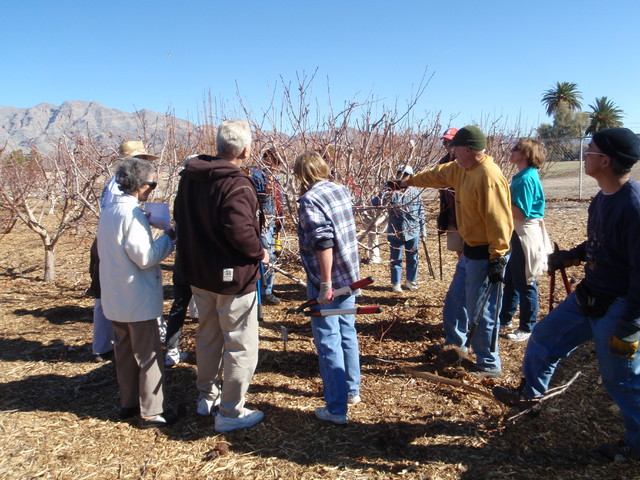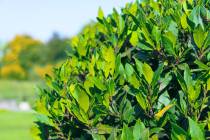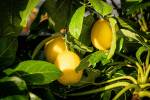Saturday class covers proper pruning techniques
I am giving a class on pruning fruit trees at the Master Gardener Orchard, 4600 Horse Drive in North Las Vegas, from 9 a.m. until noon Saturday. The class is free and open to the public. For more information call the master gardener help desk at 702-257-5555. More classes will be offered at the orchard on pruning fruit trees every Saturday during the month of January.
Pruning of trees and shrubs can begin any time after leaves drop. Actually, light pruning is done any time of the year if using nothing more heavy-duty than hand shears. Heavy pruning, the removal of large limbs with a saw or loppers, should be done only during winter months.
At the start of pruning, sharpen pruning tools and disinfect them with alcohol, Lysol or other disinfectant. It is not necessary to disinfect pruning tools between trees unless a tree appears to be sick.
When working with a landscape company to prune your trees or shrubs, make sure they disinfect their tools before they begin pruning. You have no idea if the last property had infested trees and shrubs or not.
Once pruning tools have been disinfected, do not lay them on the ground. There are several diseases of trees and shrubs that can contaminate pruning equipment if in contact with the soil. If this happens, disinfect pruning equipment again.
Limbs and branches should be removed entirely from the trunk or a larger branch, leaving a very small remnant still attached to the trunk or limb. The basic rule of thumb is to remove an entire branch while making the smallest cut possible.
Q: I planted a 24-inch boxed Chinese pistache. After it was in the ground, I removed the nursery planting stake. Now the trunk has a curve in it. Will properly restaking help straighten the trunk?
A: The tree requires staking but not because the trunk is not straight. This will correct itself on its own over time. The tree requires continued staking for other reasons. But you should do it correctly so that this problem eventually disappears.
Unfortunately, the production nursery that grew this tree did a bad job. The retail nursery that bought this tree got it at a good price. They are both at fault because they passed these problems on to you and they both knew better. Caveat emptor, buyer beware.
Look at the trunk of the tree. Notice that it does not have a lot of taper to the trunk. What I mean by taper is that the trunk diameter changes gradually along its entire length.
This is the reason it does not stay erect on its own and requires staking. In a strong wind, because of the lack of taper to the trunk, this tree could snap in two. If the trunk had taper, it is less likely to snap in a strong wind.
Trees with a trunk that has a lack of taper are grown too close together in the field and pruned to encourage height at the expense of trunk taper. The tree is staked because it cannot support its own canopy weight.
What to do to correct this problem? You must continue to stake this tree or it will snap in a strong wind. Guaranteed. Where the stake is tied to the tree is important.
Bending and flexing of the trunk is important in the development of trunk taper. If the tree is staked so the trunk cannot flex back and forth, staking will contribute further to this problem.
Secure the trunk to a stake or stakes as low on the trunk as possible, making sure the tree remains erect. The bottom of the trunk and rootball should not move but the top should. The top of the tree should flex back and forth, but not the bottom.
This would be roughly about halfway up the trunk. Each year try tying the stake to the tree lower and lower. Normally, most plants are staked no longer than one season of growth. These types of trees require staking a lot longer.
Secondly, if shoots grow from the trunk, do not prune them off! Young shoots contribute to trunk taper. Remove them when they get older, about pencil diameter, allowing young shoots to remain. Once the tree no longer requires staking, then keep the trunk clean of any new growth.
Next time, consider trunk taper and the presence of side shoots along the trunk when purchasing a staked tree.
Q: Help me decide if I can keep my 12-year-old chinaberry tree. I fear it has sooty canker disease because it has branches dying. But it does not have peeling bark. I would like to keep it at least one more spring if this disease does not spread to other trees.
A: Regardless of whether you keep it or not, the tree needs to be pruned at least to remove dead branches. Once dead limbs are removed and examined, it will be easier to see if it is sooty canker disease.
If this disease is confined to limbs and does not enter the trunk, it is possible to save the tree by removing them. It will be your decision if the tree is worth saving.
Sooty canker disease attacks many different plants but seems to favor mulberry, poplar or cottonwood, apple trees and chinaberry. It is called sooty canker because the dead wood, just under the peeling bark, is covered in a black powder that looks exactly like a heavy layer of soot in a well-used fireplace chimney.
This disease frequently enters the plant through limbs damaged by intense sunlight or wounds left by pruning with contaminated hand shears or chainsaw. It may spread from tree to tree by birds, but the most common means of spreading this disease is with contaminated pruning equipment.
Always make sure saw blades and pruners are sanitized between cuts. It is possible to save the tree by removing dead, infected branches but you must sanitize equipment between cuts if the tree is infected.
Sooty canker usually attacks trees weakened for other reasons, so make sure the tree is receiving enough water and is otherwise healthy. Apply a single fertilizer application each year in early spring.
Yes, you could prune now or early spring. This disease does not spread quickly, and the disease must be transported between trees in some way. But if the disease is in the trunk it is a goner.
Q: I discovered from the internet that soft rock phosphate apparently does not work in alkaline soil. Does our Las Vegas soil contain any phosphate? I wonder if, in long term, it can be unlocked with some fungi or something like that.
A: There is some phosphorus in all soils. The question becomes whether there is enough phosphorus in the soil to support what we are trying to grow.
When we grow vegetables and fruit trees in soils, these plants take minerals from the soil and store them in their leaves, flowers and fruit, stems and roots. We eat roots, stems, leaves and fruits of different plants. This is how we get the minerals in our body to support our health.
When we grow plants and harvest them, we remove whatever minerals they removed from that soil. These minerals need to be replaced in the soil. We replace them by applying soil amendments such as compost or fertilizers or both to these soils.
Some minerals are needed in large amounts by plants while others are needed in small amounts. Phosphorus is needed in large amounts. When we intensively grow vegetables and fruit in a small area and harvest them, nutrients need to be put back in the soil.
Phosphates found in fertilizers provide enough phosphorus for most plants. Adding compost to the soil supplies the microorganisms needed to help plants use this phosphorus. As long as the soil is healthy and vibrant by using amendments such as good quality compost, the type of phosphorus added will not make much difference.
Bob Morris is a horticulture expert living in Las Vegas and professor emeritus for the University of Nevada. Visit his blog at xtremehorticulture.blogspot.com. Send questions to Extremehort@aol.com.




























